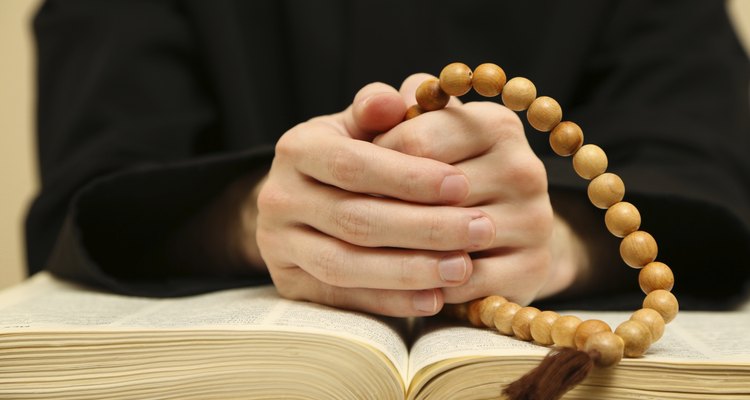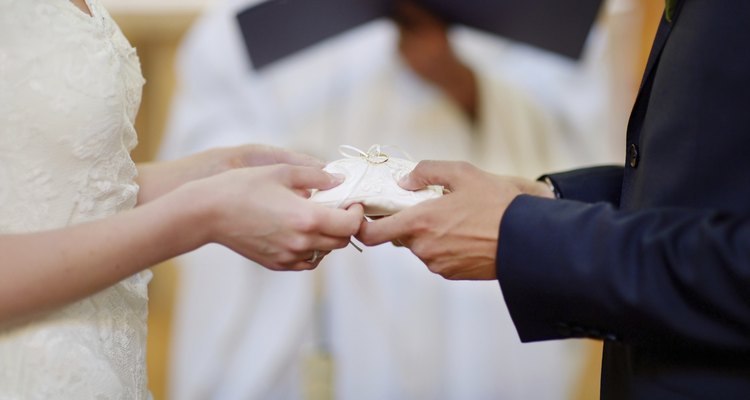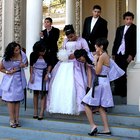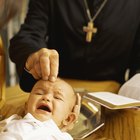
Rauluminate/iStock/Getty Images
Mexican wedding traditions date back to ancient Aztec times of the 14th and 15th centuries. Many of the Catholic customs were introduced when the Spanish came to Mexico and conquered the Aztec Empire in 1521. Several of these traditions have been passed down through generations of Mexican families for centuries.
Marriage Preparation

belchonock/iStock/Getty Images
Mexican Catholic couples usually participate in a pre-marriage preparation course, given at their local church, to make sure they are prepared for their married life together. The course is generally completed within a few hours, and consists mostly of talking through issues with your church's priest, such as when they want to have their first child together, the stresses involved with marriage and raising a family, and the role of faith within a marriage. Depending on your church or situation, your priest may require additional counseling before the wedding takes place. The course also attempts to provide the couple with a realistic vision of what married life will be like.
El Padrino y La Madrina (Godparents)

maximkabb/iStock/Getty Images
Traditionally, the couple chooses their godparents, who will advise and guide them throughout their engagement, wedding ceremony, and all throughout their lives. It is considered a great honor to be chosen as a "padrino" or "madrina." The padrinos and madrinas are sponsors for the wedding; at the very least, they provide the couple with a Bible and rosary as a way to bless the marriage. They also have a special place near the bride and groom during the ceremony.
There is also another kind of madrina: "La Madrina de Ramo," a young female child who brings a special bouquet of flowers to be given to the Virgin Mary during the ceremony.
The Bride's Prayer Before the Ceremony

IPGGutenbergUKLtd/iStock/Getty Images
At a traditional Mexican Catholic wedding, the mother of the bride or both her parents say a prayer to bless the bride and her husband-to-be with a prosperous new life together. The bride sometimes takes part in saying the prayer as well. It is the mother's (or parents') way of blessing the wedding and honoring her daughter formally.
Thirteen Gold Coins

BackyardProduction/iStock/Getty Images
One of the most popular Mexican Catholic wedding traditions is the 13 gold coins or arras. In this tradition, the groom presents the bride with 13 gold coins that are blessed by the priest during the ceremony. The coins represent the groom's certitude and indisputable trust. It is also considered a declaration of the groom's possessions. When the bride accepts the grooms' coins, she commits to honor his certitude and trust. Often the coins have been in the family for generations and are passed down at each wedding.
The Kneeling Pillow and El Lazo (The Lasso)

maximkabb/iStock/Getty Images
The kneeling pillow is a special pillow for the couple provided by a designated bridesmaid. The couple spends most of the ceremony kneeling on the pillow at a traditional Catholic mass.
The lasso is a large rosary or white ribbon. It is placed in a figure-eight shape around the bride and grooms' necks or around their wrists during the ceremony. This symbolizes the couples' union and unbreakable bond of their love and trust.
Related Articles

Wedding Prayers of the Faithful

Traditional Duties of a Maid of Honor ...

How to Use a Veil & Cord in a Wedding

Romanian Orthodox Wedding Traditions

What Is the Proper Way to Get Married ...

The Purpose of Christening

Mexican Wedding Traditions

What Does the Godmother Do for the ...

What a Minister Says at a Wedding

What Are the Duties of a Godparent?

How to Officiate a Wedding Renewal

What Is the Godparents' Responsibility ...

Can I Be the Godmother of My Little ...

Mexican Quinceanera Traditions

The Godfather's Responsibilities on the ...

Role of a Godmother During a ...

What Is the Symbolism of Jumping the ...

Religious Ideas for 50th Wedding ...

Greek Orthodox Funeral Traditions

The Meaning of a Flower Girl in a ...
References
Writer Bio
Chris Newton has worked as a professional writer since 2001. He spent two years writing software specifications then spent three years as a technical writer for Microsoft before turning to copywriting for software and e-commerce companies. He holds a Bachelor of Arts in English and creative writing from the University of Colorado.
Photo Credits
Rauluminate/iStock/Getty Images